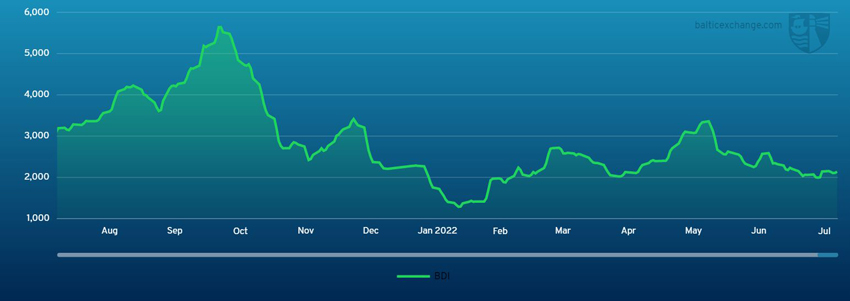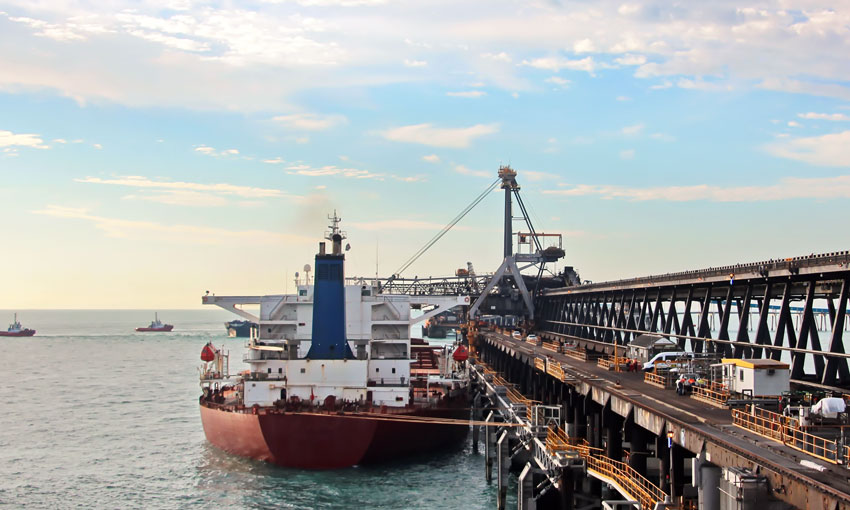THE Baltic Dry Index was relatively steady over the past week. On Friday (22 July) it stood at 2146. This was roughly in line with where it ended the previous week.

Capesize
A mixed week for the Capesize sector, but it ended on a positive note. The timecharter average of the five routes rose above the US$20,000 level and closed at US$22,362 on Friday.
Activity was largely seen from the Pacific, including coal from Indonesia and iron ore from West Australia to China. The latter maintained above US$11 with a marginal improvement compared to the end of last week. Tonnage availability looked tight for ballast trades for first half of August.
As the week finished, the Brazil market saw more second-half August enquiry and settled at US$32.111 for iron ore from Tubarao to Qingdao.
In the North Atlantic, fronthaul and transatlantic business appeared to be less active than recently, declining week-on-week to US$30,278 and US$47,083 respectively.
Panamax
Something of a midweek push gave the Panamax market a much-needed boost. However, the week did end on a somewhat subdued note as market players adopted a cautious approach.
The north Atlantic began the week brightly with a glut of transatlantic deals concluded basis delivery APS load port in the low US$30,000s. This equated for BKI types to circa US$17/18,000 delivery this side, whilst East Coast South America saw better demand for second-half August arrival dates. An 82,000-dwt delivery Passing Muscat Outbound achieved just over US$20,000 for a trip via EC South America redelivery Singapore-Japan midweek.
Asia, for weeks, has been primarily Indonesia coal-centric. But the market was marginally better supported this week by Australian coal, which was primarily destined for India. A 81,000-dwt giving delivery South China fixed at US$19,000 for a trip via Indonesia to India. Period news included an 81,000-dwt delivery China achieving just shy of US$20,000 for a five-to-eight-month period.
Ultramax/Supramax
Overall, a slightly more positive week than of late.
The Atlantic saw improved activity from the US Gulf region and also stronger demand from East Coast South America for August dates. A good amount of enquiry helped sentiment gain ground from South East Asia. However, there was ample supply of tonnage.
On the period front, limited activity was seen. A 61,000-dwt was rumoured to have fixed a short period around US$26,000. The Atlantic saw a 58,000-dwt fixing a US Gulf fronthaul redelivery Japan at US$28,000 and a 52,000-dwt fixing from Mobile for a trip to East Coast South America in the low US$27,000s.
From Asia, A 52,000-dwt fixed delivery Singapore for a trip via Indonesia redelivery China at US$24,000. For Australian business, a 58,000-dwt was heard fixed delivery Singapore via Australia redelivery Singapore-Japan at around US$25,000. From the Indian Ocean, 63,000-dwt open East Coast India was heard to have fixed a trip to West Africa with bagged rice in the upper US$20,000s.
Handysize
A positive week in both basins despite limited visible activity. East Coast South America remained buoyant, with a 32,000-dwt fixing from Santos to Morocco at US$27,000 and a 35,000-dwt rumoured to have fixed from South Brazil to Morocco at US$29,000. A 37,000-dwt was fixed from Fairless Hills via North Brazil to Norway with alumina at US$17,500.
From the Mediterranean/Continent, a 32,000-dwt fixed from Safi to Chittagong with fertiliser at US$19,000. Also, a 32,000-dwt fixed from Çanakkale via the Black Sea to Algeria at US$18,000. From Asia, it was a mixed bag. A 38,00-dwt was rumoured to have been covered for a trip from CJK via Australia to China at US$20,500. A 37,000-dwt was also rumoured to have been placed on subjects for a trip delivery Singapore via Australia redelivery China at US$22,500. Period activity remained sparse, but a 38,000-dwt open Santos was rumoured to have fixed for three to five months trading at US$27,500.
Clean
The Middle East Gulf CPP market has seen a mix of movements this week on the different sizes. On the LR2s TC1 continued its upward trend rising 22.59 points to WS226.88 with reports of WS230 on subjects for this run on Friday morning.
LR1s have been stable with sufficient tonnage and cargoes around to maintain last done rates. We have seen TC5 repeated at W290, which is where the index has floated around (+/- a few WS points) all week. The MRs continued their resurgence this week seeing the TC17 index jumping 30.83 points to WS495 and firmly taking the round trip TCE for this voyage up into the high US$40,000s.
In the West, the LR2s of TC15 have ticked up a little this week this benchmark currently sits at US$3.95m (+US$70,000), we understand this is off the back of the improved TC1 market. On TC16 the LR1s has been steady all week pegged around the WS230 mark.
On the UK-Continent the MR freight levels have suffered as supply has outweighed demand with reports of vessels also ballasting in. TC2 has haemorrhaged 38.61 points to end up at 275.83 by the end of the week (US$22,700 per day round trip TCE) and TC19 also lost 40.71 points to currently sit at WS282.86.
The USG MR market has been retested upwards this week. Between vessel ballasting away, Panama Canal delays and higher activity levels TC14 has hiked up to WS220.83 (-WS39.16) and TC18 has similarly risen WS41.66 to WS323.33 (US$34,800 per day round trip TCE).The MRA TCE saw an upturn from 35,213 to 37,353.
On the Handymax cross Mediterranean freight levels continued to slide, TC6 lost another WS51.87 to end up at WS219.38 by the end of the week.
In the Baltic, TC9 has still held on at around WS505 this week with the TCE continuing at US$60,00 per day.
VLCC
VLCC rates continued climbing this week. 270,000mt Middle East Gulf/China rates improved by three points to the WS61.5 level (a round-trip TCE of US$4,800 per day), while the rate for 280,000mt Middle East Gulf/USG (via Cape of Good Hope) gained 1.5 points to WS35.5.
In the Atlantic, another active week resulted in rates for 260,000mt West Africa/China rising three points to almost WS62.5 (US$6,300 per day round-trip TCE) and 270,000mt US Gulf/China went up US$268,750 to a little over US$7.45 million (showing a round-trip TCE of US$3,100 per day).
Suezmax
Rates for 135,000mt Black Sea/Augusta climbed 41 points to WS202 (a round-trip TCE of US$82,500 per day) on the back of increasing demand in other nearby regions causing the tonnage list to be significantly squeezed. Rates for the 130,000mt Nigeria/UKC trip, despite little activity, rose six points midweek and now remain steady at the WS140 level (a round-trip TCE of US$36,300 per day). In the Middle East the rate for 140,000mt Basra/West Mediterranean gained four points to WS83.
Aframax
The Mediterranean market got off to a slow start then gathered a lot of pace midweek. The rate for 80,000mt Ceyhan/West Mediterranean rocketed 92 points week-on-week to WS271.5 (a round-trip TCE of US$78,200 per day).
In Northern Europe the rate for 80,000mt Hound Point/UK Continent eased a further six points to WS191.5 (a daily round-trip TCE of US$53,900). For the 100,000mt Primorsk/UK Cont route rates fell eight points to WS231.5 (a round-trip TCE of US$74,000 per day).
Across the Atlantic, a mini resurgence occurred early on. However, at the time of writing the market is on the slide. Rates for 70,000mt EC Mexico/US Gulf, having climbed 10 points to WS310 by midweek, were last assessed on Thursday at WS304 (a round-trip TCE of US$70,100 per day).
The 70,000mt Caribbean/US Gulf trip faced a similar situation with rates climbing 20 points to WS263 by midweek but have now slipped to the WS250/252.5 region (a round-trip TCE of about US$45,600). For the transatlantic trip of 70,000mt US Gulf/UK Continent rates have climbed steadily and are now assessed 29 points firmer than a week ago at WS253 (US$45,900 per day round-tip TCE).

